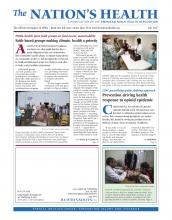Rural Americans face a greater risk of losing their lives to the nation’s top leading causes of death, including unintentional injury. In fact, research finds that unintentional injury fatalities are 50 percent higher in rural communities than in urban ones, due in part to greater risks of traffic crashes and opioid overdoses.
About 46 million Americans live in rural communities, which the Centers for Disease Control and Prevention reports are often home to economic and social factors that exacerbate the risk of dying from an injury, such as less access to health care, more people without health insurance and greater rates of poverty. A study published in January in CDC’s Morbidity and Mortality Weekly Report found that more than half — or about 12,100 — of unintentional injury deaths in rural communities were likely preventable, compared to about 39 percent of unintentional deaths in metropolitan areas.

Rural Americans face a greater risk of losing their lives to unintentional injuries.
Photo courtesy Kevinruss, iStockphoto
Preventable injury deaths were higher in rural communities throughout most of the country, the study found. For instance, in rural areas of Arizona, California, Hawaii and Nevada, 65 percent of such deaths were potentially preventable, versus 29 percent in the states’ more urban areas.
Addressing injuries is also among the top 20 priorities of Rural Healthy People 2020, a document that sets health objectives for rural America.
In March, MMWR published more worrisome findings on injury in rural communities, reporting that the gap in suicide rates between rural and urban communities has gotten wider. Using data from the U.S. Census and National Vital Statistics System, researchers found that suicide rates increased overall between 1999 and 2015, accelerating significantly around the time of the Great Recession.
Suicide rates at the beginning of the study period were lowest in more urban counties and highest in less urban ones, with that gap growing bigger over time. Researchers said the higher rural rates could be associated with a range of suicide risk factors, such as less access to mental health services, shortages in behavioral health providers and greater social isolation.
Researchers noted that opioid addiction and overdose are likely worsening rural suicide rates. The opioid epidemic has hit rural communities particularly hard and addressing the problem is made even more difficult by a lack of addiction treatment services in rural areas.

Rural areas are often home to factors that worsen the risk of dying from an injury, such as less access to health care.
CDC recommends a number of low-cost interventions to help bring down injury deaths in rural communities. For instance, rural health care providers can educate patients about seat belt use, which is much lower in rural communities than in urban ones. Providers can re-examine and potentially shift their opioid prescribing practices — CDC released its evidence-based guidelines on prescribing opioids for chronic pain last year. And strengthening programs and policies that draw mental health providers and services to rural communities could go far in reducing suicide rates.
For more resources on injury in rural communities, visit www.cdc.gov/ruralhealth.
- Copyright The Nation’s Health, American Public Health Association









